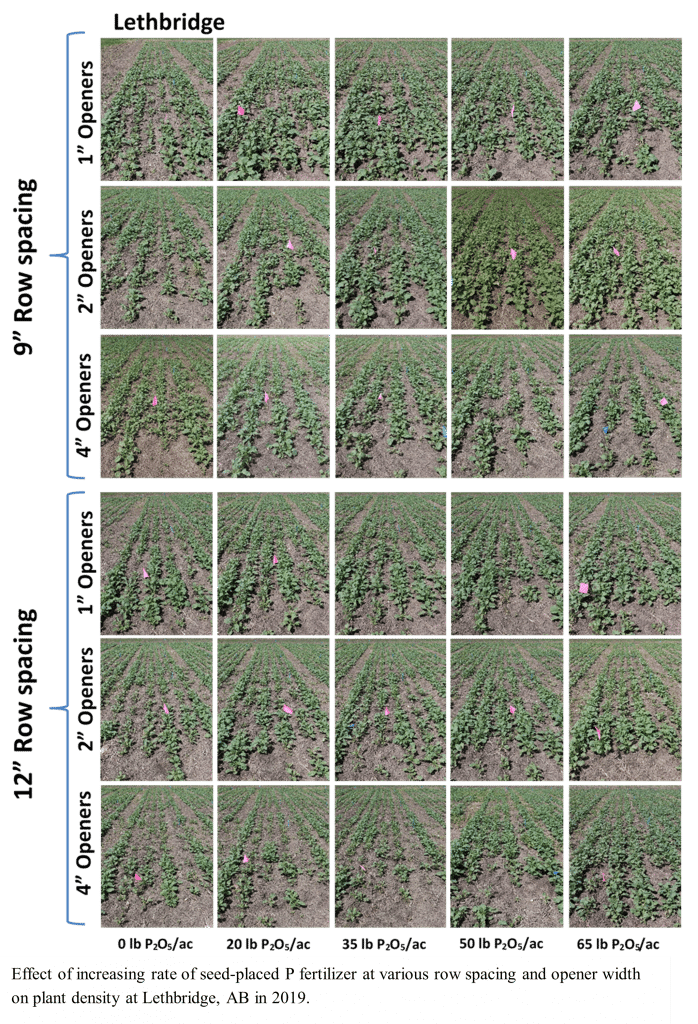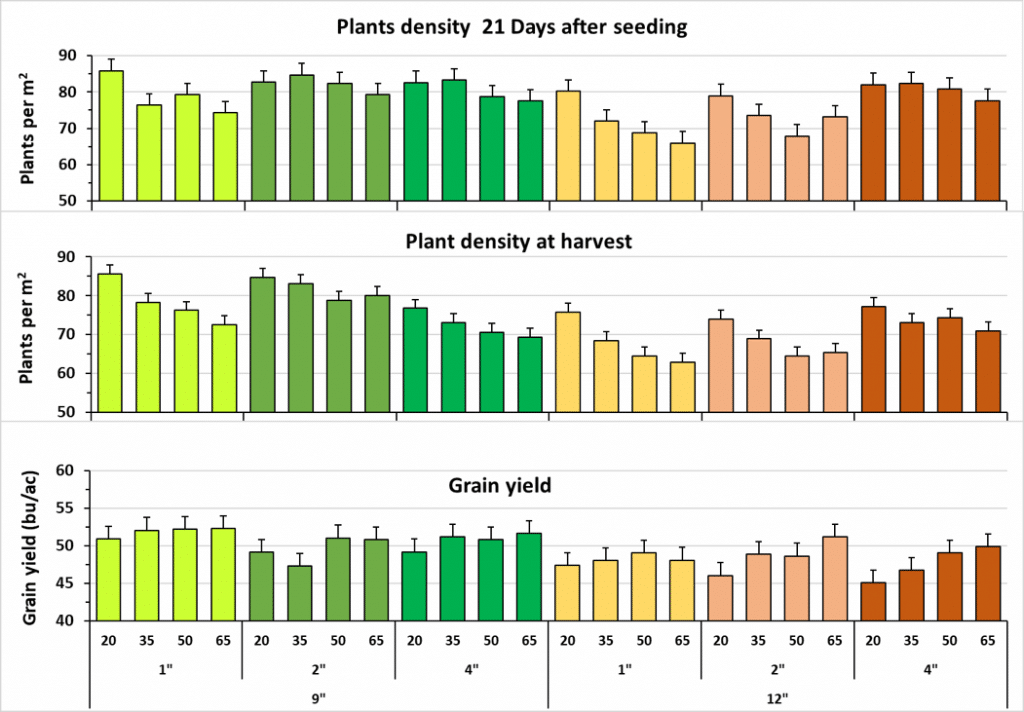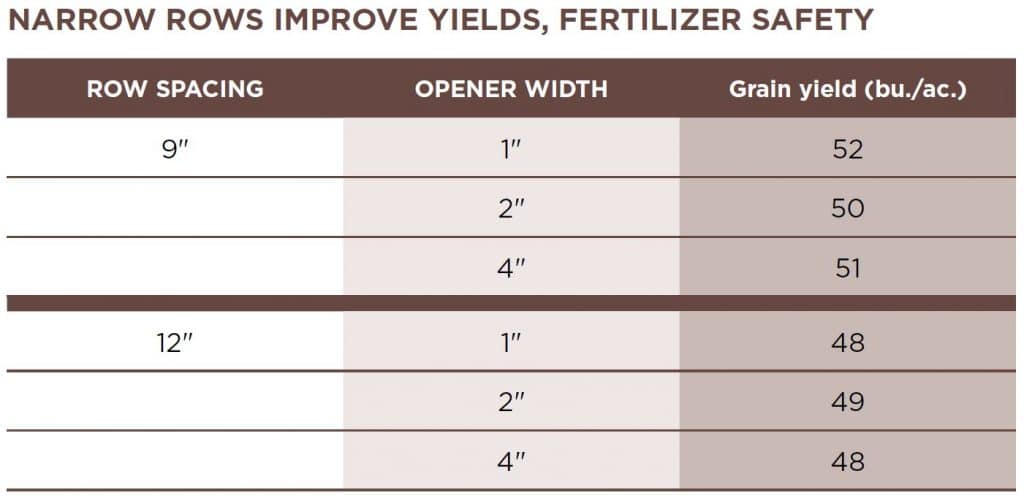Key Result
Producers who are placing nitrogen (N) and sulphur (S) fertilizers away from the seed have more room to increase seed-placed phosphorus fertilizer without causing significant reduction in plant density and grain yield of canola. Opener configuration does not greatly influence phosphorus fertilizer recovery from seed-row placed phosphorus fertilizer.
Project Summary
Overview
Phosphorus requirements of canola can be met through seed row placement without significant reduction in grain yield and quality as long as nitrogen and sulphur fertilizers are not placed in the seed row. The safety of the seed-placed phosphorus can be enhanced by using 2″ to 4″ openers for those using 12″ row spacing. For producers using 9″ row spacing, opener width should not exceed 2″, unless slower seeding speed is used. Alteration of seed bed utilization (SBU) will not significantly affect phosphorus fertilizer recovery by the canola.
Purpose

Current maximum safe rate of seed-placed phosphorus fertilizer guidelines are based only on one configuration (1″ opener and 9″ row spacing. At this configuration, the safe rates of seed-placed phosphorus (in pounds P2O5 per acre) for canola are 15, 20 and 25 for Alberta, Manitoba and Saskatchewan, respectively. However, these rates are not adequate to meet phosphorus requirements of canola. Hence, the objectives of this project were to determine the maximum safe rate of seed-placed phosphorus fertilizer with different opener widths and row spacing, and to develop guidelines for producers and crop advisors to use.
Methodology
A two-year (2018 & 2019) field study was conducted at five locations: Saskatoon, Melfort and Scott in Saskatchewan, and Brooks and Lethbridge in Alberta using the following treatments: Row Spacing at 9″ and 12″; Opener Width at 1″, 2″ & 4″; and phosphorus rate at 20, 35, 50 and 65 pounds P2O5 per acre. The treatments were arranged in a randomized complete block design with four replications at each location. The treatments were applied by a custom-built drill fitted with Morris Contour 1 shanks and rollers and Dutch Universal openers with the flexibility of changing opener width and type as well as row spacing easily. In 2018 plot size was three by ten metres. In 2018 a blend of urea (46-0-0) and ammonium sulphate (21-0-0-24) was banded to a depth of three inches at 140 pounds nitrogen per acre and 20 pounds sulphur per acre using 1″ knife openers on the plot drill. To avoid compaction observed in 2018, in 2019, plot size was reduced to 1.2 metre by 15 metre, so that plots could fit within the breadth of tractor tire tracks, single disk openers were fitted on the front bar of the plot drill as mid-row openers and used to band the blend of urea and ammonium sulphate. In both 2018 and 2019, phosphorus fertilizer was seed-placed at the treatment rate. As well, in 2019, a check plot at 0 pounds P2O5 per acre was included, bringing the total of treatments per rep to 30.
Notable conditions
Lack of precipitation at most locations contributed to the reduced treatment effects. Under very dry conditions in both 2018 and 2019, the seeds did not have sufficient moisture to initiate the germination process. This may have been exacerbated by the presence of phosphorus fertilizer. It is speculated that this lag in time may have resulted in gradual reduction in phosphorus toxicity, resulting in a lower reduction in plant density with increasing phosphorus rate than expected. This may sound ironic because guidelines indicate that phosphorus fertilizer toxicity may be exacerbated by low soil moisture conditions. Under dry conditions of 2019 in particular, canola seed simply remained dormant and did not germinate until soil moisture became available.
In this study, the researchers observed less toxic effects of seed-placed phosphorus fertilizer at different SBU ratios than expected, indicating that, canola can tolerate higher levels of seed-placed phosphorus when nitrogen and sulphur are not placed with the seed. By banding the nitrogen and sulphur fertilizer away from the seed, the researchers removed a significant source of toxicity which, otherwise, would enhance toxicity of seed-placed phosphorus in canola.
The researcher suspect that the seeding speed was a little too high for the 9″ row spacing and 4″ opener width combination. This affected, in particular, 2019 results at a few locations.
Results
Results of this study indicate that increasing seed bed utilization (SBU) by either narrowing row spacing from 12″ to 9″ and/or increasing opener width from 1″ to 4″ results in reduced phosphorus toxicity of seed-placed phosphorus fertilizer, leading to increased number of plants per unit area. Alteration of SBU did not consistently influence the plant recovery of fertilizer phosphorus for a given rate of phosphorus application, and SBU does not appear to be a major factor affecting utilization of fertilizer phosphorus by canola. Increasing the rate of seed-placed phosphorus increases the toxic effect on seed and seedlings, leading to reduced plant population. This toxicity was reduced by increasing SBU thus, reducing the concentration of phosphorus fertilizer near the seed. Despite the reduction in plant population with increasing rate of seed-placed phosphorus fertilizer, significant increase in grain yield was observed in response to phosphorus, albeit small absolute increments. This is usually attributed to the compensatory abilities of the canola plant which takes advantage of the reduced plant population by branching out more such that the individual plants that survive produce more than they would at a higher plant population. However, it’s speculated that while increasing phosphorus rate resulted in increased phosphorus toxicity, leading to death of some seed and seedlings, the increased amount of available phosphorus helped surviving plants at higher rates of phosphorus yield better than the more numerous plants at low rates of phosphorus.

Notable observations
Increased opener width can cause seeding problems. In many cases, the combination of 9” row spacing and 4” opener width threw too much soil on rows of front openers, which buried the seeds and reduced plant population. This problem was most pronounced on soils with a clay texture. One solution is to reduce seeding speed.
In this study, grain yield was lower with all opener sizes at 12″ row spacing than with 9″ row spacing.
While increasing phosphorus rate resulted in increased phosphorus toxicity, leading to death of some seed and seedlings, the increased amount of available phosphorus helped the surviving plants achieve higher yield.
Toxic effects of seed-placed phosphorus fertilizer were less than expected. This indicates, the researchers say, that canola can tolerate higher levels of seed-placed phosphorus when nitrogen and sulphur are not placed with the seed.
Conclusions
In conclusion, the researchers think that this study did not have sufficient information to change the guidelines for safe maximum rates of seed-placed phosphorus fertilizer for canola. One limitation is that the study excluded seed-placed nitrogen and sulphur, so the higher rates of seed-placed phosphorus looked safe enough.
The second limitation was the failure to separate the beneficial effect of increased phosphorus rate with the compensatory ability of a canola crop. While increasing phosphorus rate resulted in increased phosphorus toxicity, surviving plants with higher rates of phosphorus yielded better than the more numerous plants at low rates of phosphorus. The study needed to supply the same amount of phosphorus to all treatments, using the same seed-placed treatments with the balance side banded. The third limitation was time. Two years were not sufficient to lead to strong conclusions of the findings.

Increasing rate of seed-placed phosphorus fertilizer can cause significant reduction in plant density due to increased toxicity of the phosphorus fertilizer to canola seeds and seedlings. This can be mitigated by increasing the width of the openers, and/or using narrow row spacing; thus increasing seedbed utilization (SBU). However, the impact on yield and quality of the canola is small, reflecting the compensatory capability of canola under reduced plant density. This confirms the anecdotal belief among producers that higher rates of seed-placed phosphorus fertilizer can be applied without hurting canola yield and quality. The seed bed utilization was not a major factor affecting uptake of the seed-row placed phosphorus fertilizer by canola.
Application
Producers seeding at 12″ row spacing should avoid using openers less than 2″ wide if seed-placing phosphorus fertilizer. At 12″ row spacing, using 4″ wide openers could help reduce toxicity of seed -placed phosphorus fertilizer. If seeding at 9″ row spacing, opener width should not exceed 2″ as doing so could result in too much soil being thrown over rows seeded by front row openers. Producers who are placing nitrogen (N) and sulphur (S) fertilizers away from the seed have more room to increase seed-placed phosphorus fertilizer without causing significant reduction in plant density and grain yield of canola. Opener configuration does not greatly influence phosphorus fertilizer recovery from seed-row placed phosphorus fertilizer.
References:
Grenkow, L. 2013. Effect of Seed-Placed Phosphorus and Sulphur Fertilizers on Canola Plant Stand, Early Season Biomass and Seed Yield. Thesis. University of Manitoba Winnipeg, MB. https://mspace.lib.umanitoba.ca/bitstream/handle/1993/22150/Grenkow%20MSc%20Thesis%20(July%2030)%20df2.pdf?sequence=1
McKenzie, R. 2014. Determining safe rates of seed-placed fertilizer – Understanding fertilizer injury is the first step https://www.topcropmanager.com/fertility-nutrients/determining-safe-rates-of-seed-placed-fertilizer-16268
Lemke, R. L., Mooleki, S. P., Malhi, S. S., Lafond, G., Brandt, S., Schoenau, J. J., Wang, H., Thavarajah, D., Hultgreen, G. and May, W. E. 2009. Effect of fertilizer nitrogen management and phosphorus placement on canola production under varied conditions in Saskatchewan. Can. J. Plant Sci. 89: 2948.
Malhi, S. S. and Gill, K. S. 2004. Placement, rate and source of N, see-drow opener type and seeding depth effects on emergence, yield, seed quality and N uptake of canola. Can. J. Plant Sci. 84: 719-729.
Mooleki, S.P. 2016. Seed safety at high rates of seed-placed phosphorus fertilizer with increased seedbed utilization. Final Report submitted to Saskatchewan Ministry of Agriculture. ADOPT Project #: 20140399.
Qian, P., Schoenau, J. J., King, T. and Fatteicher, C. 2005. Preliminary Study on Impact of Seed-row Place P Fertilizer on Emergence and Yield of 10 Crops Under Controlled Environment Conditions. http://www.usask.ca/soilsncrops/conference-proceedings/previous_years/Files/2005/2005DOCS/081.pdf





